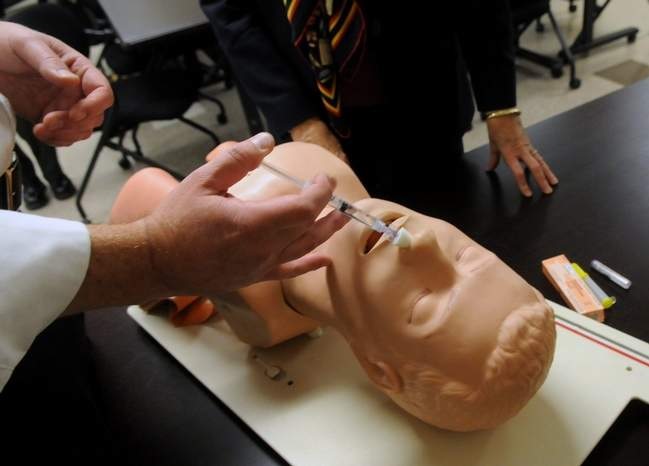Shaheen and first responders talk Narcan
Hampton personnel administered Narcan 38 times this year

HAMPTON — U.S. Sen. Jeanne Shaheen, D-N.H., met with first responders in Hampton on Friday morning to hold a roundtable discussion about the statewide opioid crisis and Narcan, the drug used to revive users from an overdose.
Shaheen was joined by Hampton fire and police chiefs, deputy police chief and members of the Hampton EMS team at the Hampton Fire Department. She was also given a Narcan demonstration by EMS officer Nate Denio.
Denio said his Fire Department has administered Narcan 38 times this year. Narcan was only used 12 times in 2009.
“I’m sure that number will grow (this year),” Denio told Shaheen.
Denio described Narcan as kicking the opioid out of the body’s opioid receptors, taking the user out of the overdose. It’s typically administered through the nose. Because it has no side effects, first responders administer it if there’s the slightest sign of an overdose. A bill last year made it legal for people other than first responders to possess Narcan without a prescription.
Denio, Hampton Fire Chief Jameson Ayotte and Hampton paramedic Craig Jordan said there are still misconceptions regarding Narcan. One is that users experiencing an overdose do not need medical attention after being administered Narcan. Narcan wears off after approximately 20 minutes, Ayotte said.
Another is that one packaged dose of Narcan brings users back from any overdose. In fact, a heroin user experiencing an overdose may have injected himself or herself with a dose too high for the intranasal Narcan dose administered by first responders. Eight of the 38 people who were administered Narcan this year required a second dose, Denio said.
“There’s a little bit of false security that (Narcan) is going to change the outcome of what happened,” Denio said.
The first responders also told Shaheen about their concern regarding the rate at which hospital patients are prescribed opioids to treat pain. Multiple health and government officials have said heroin addiction for many people followed the use of pain medication prescribed by a doctor.
Jordan said the decision to give a narcotic to a patient in the ambulance can be a difficult one.
“They’re in pain, but it’s like, I can give you a narcotic to put you at ease, but I don’t want to give you too much,” Jordan said. “But with a lot of hospitals, they’re like, ‘No, treat the pain (with pain killers).’”
Shaheen said she shared that concern.
“We have people getting all this medication when they don’t really need it,” she said. “That’s what I think is a really big piece of what we’ve got to do. Try and get the medical community to focus in on that.”
Shaheen said it’s important for the public to understand what Narcan does and what it means for communities dealing with drug addiction. She came to Hampton because of how the town has faced challenges with heroin this year.
“I think there’s been a lot of talk about Narcan in the media and the press and what’s important I think is for people to see what that actually means,” Shaheen said. “How do you actually administer it? What does it really do? And to hear the experts talking about that and talking about the challenges with Narcan, I think, is really important. That’s really why I came here.”
U.S. Sen. Jeanne Shaheen speaks with Hampton fire and police at the fire station about how they administer the drug Narcan and how it relates to the heroin and opioid abuse epidemic in New Hampshire. PHOTOS BY DEB CRAM/SEACOASTONLINE
Hampton emergency medical services officer Nate Denio demonstrates one way his team administers Narcan, which offsets the effects of heroin and other opioids. U.S. Sen. Jeanne Shaheen visited the fire station to speak with fire and police personnel and learn more about Narcan and their responses to overdoses in the Seacoast town.
Source:
Portsmouth Herald

